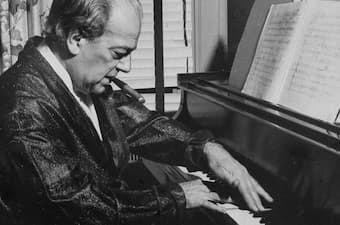Heitor Villa-Lobos: The Martyrdom of Insects

Heitor Villa-Lobos
Brazilian composer Heitor Villa-Lobos (1887-1959) is considered ‘the single most significant creative figure in 20th-century Brazilian art music.’ Immensely prolific, at his death he left some 2,000 works, many of which had gained international popularity.
He drew heavily on Brazilian tradition at a time when Brazilian music was starting to find an international audience and, infusing it with some ideas from European classicism, created unique works such as the Bachianas Brasilieras, which merged the Baroque stylings of Bach with Brazilian ideas.

periodical cicada
One of his interesting character pieces looks at insects. Bugs have a short life and Villa-Lobos looked at three of them from interesting perspectives.
He starts with what is again the insect of the summer – the cicada. As Brood X emerges for its brief life on the US East Coast, its buzz will carry through many a night before its next 17-year sleep. Villa-Lobos imagined the end of life for a cicada, its buzzing still there in the piano, but he’s dying. The melody moves in half steps interrupted by brief brilliant florid passages.
Heitor Villa-Lobos: O Martírio dos Insetos (The Martyrdom of Insects) (version for violin and piano) – I. A cigarra no Inverno (The Cicada in Winter) (Francesca Anderegg, violin; Erika Ribeiro, piano)
The beautiful firefly, which can only be seen at night, makes its appearance in the 2nd movement. It darts here and there, vainly seeking another. Since it’s in the light and not in the dark, its actions may, in the end, have no result.
Heitor Villa-Lobos: O Martírio dos Insetos (The Martyrdom of Insects) (version for violin and piano) – II. O Vagalume na Claridade (The Firefly in the Light) (Francesca Anderegg, violin; Erika Ribeiro, piano)
He closes with the self-immolation of a moth, who dies fascinated by the fatal light of a candle. The fluttering of the wings is presented with an effect not unlike Rimsky-Korsakov’s Flight of the Bumblebee, although a lot less focused. The moth isn’t off on a mission, like the bumblebee, but can’t bear to tear itself away from that terrible light. And, in a flash and a tinkle, it’s all over.
Heitor Villa-Lobos: O Martírio dos Insetos (The Martyrdom of Insects) (version for violin and piano): III. Mariposa na luz (The Moth Around the Flame) (Francesca Anderegg, violin; Erika Ribeiro, piano)
They are funny little pieces, with the violin, who normally makes a much more high-brow connection with world, representing the three insects in such different ways. The work was originally written for violin and orchestra, but the reduction to violin and piano somehow seems perfect.
For more of the best in classical music, sign up to our E-Newsletter


